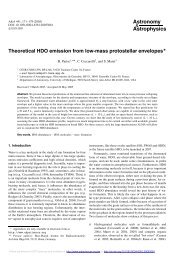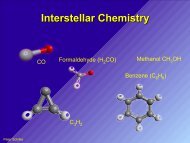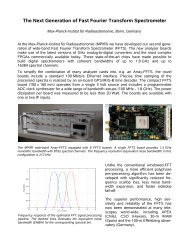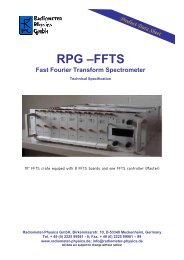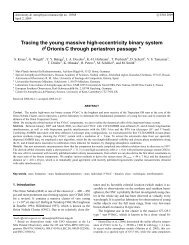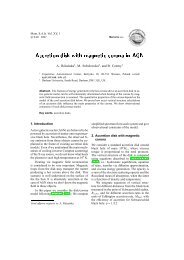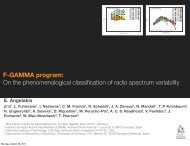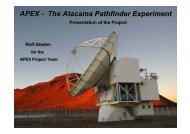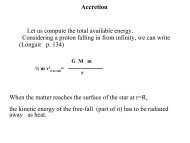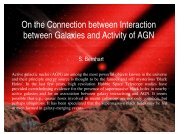Pulsars as a probe for the nuclear and quark matter equation of state
Pulsars as a probe for the nuclear and quark matter equation of state
Pulsars as a probe for the nuclear and quark matter equation of state
Create successful ePaper yourself
Turn your PDF publications into a flip-book with our unique Google optimized e-Paper software.
– p.1<br />
<strong>Pulsars</strong> <strong>as</strong> a Probe <strong>for</strong> <strong>the</strong> Nuclear <strong>and</strong> Quark Matter<br />
Equation <strong>of</strong> State<br />
Jürgen Schaffner-Bielich<br />
Institute <strong>for</strong> Theoretical Physics <strong>and</strong><br />
Heidelberg Graduate School <strong>for</strong> Fundamental Physics <strong>and</strong><br />
ExtreMe Matter Institute EMMI<br />
AG 2011 Splinter Meeting on ’A fresh view <strong>of</strong> <strong>the</strong> radio sky: science<br />
with LOFAR, SKA <strong>and</strong> its pathfinders’ Heidelberg, September 21, 2011
– p.2<br />
Simon Weissenborn, Irina Sagert, Giuseppe Pagliara,<br />
Matthi<strong>as</strong> Hempel, JSB:<br />
Quark <strong>matter</strong> in m<strong>as</strong>sive neutron stars,<br />
e-Print: arXiv:1102.2869 [<strong>as</strong>tro-ph.HE], ApJL in press
EoS <strong>and</strong> m<strong>as</strong>s-radius relation <strong>of</strong> compact stars<br />
– p.3<br />
(Weber, Negreiros, Rosenfield, Steijner 2006)<br />
many, many different <strong>equation</strong> <strong>of</strong> <strong>state</strong> EoS . . .<br />
result in various different m<strong>as</strong>s-radius relation <strong>for</strong> compact stars<br />
Tolman-Oppenheimer-Volk<strong>of</strong>f (TOV) <strong>equation</strong>: one-to-one relation between<br />
EoS <strong>and</strong> m<strong>as</strong>s-radius relation
Constraints on <strong>the</strong> M<strong>as</strong>s–Radius Relation (Lattimer <strong>and</strong> Prak<strong>as</strong>h 2004)<br />
M<strong>as</strong>s (solar)<br />
2.5<br />
2.0<br />
1.5<br />
1.0<br />
GR<br />
P <<br />
causality<br />
AP3<br />
ENG<br />
AP4<br />
J1614-2230<br />
SQM3<br />
J1903+0327 FSU<br />
SQM1<br />
J1909-3744<br />
PAL6 GM3<br />
GS1<br />
Double NS Systems<br />
MPA1<br />
MS1<br />
PAL1<br />
MS2<br />
MS0<br />
0.5<br />
rotation<br />
Nucleons Nucleons+Exotic Strange Quark Matter<br />
0.0<br />
7 8 9 10 11 12 13 14 15<br />
Radius (km)<br />
spin rate from PSR B1937+21 <strong>of</strong> 641 Hz: R < 15.5 km <strong>for</strong> M = 1.4M ⊙<br />
Schwarzschild limit (GR): R > 2GM = R s<br />
causality limit <strong>for</strong> EoS: R > 3GM<br />
m<strong>as</strong>s limit from PSR J1614-2230 (red b<strong>and</strong>): M = (1.97±0.04)M ⊙<br />
– p.4
Nuclear Equation <strong>of</strong> State <strong>as</strong> Input in Astrophysics<br />
supernovae simulations: T = 1–50 MeV, n = 10 −10 –2n 0<br />
proto-neutron star: T = 1–50 MeV, n = 10 −3 –10n 0<br />
global properties <strong>of</strong> neutron stars: T = 0, n = 10 −3 –10n 0<br />
neutron star mergers: T = 0–100 MeV, n = 10 −10 –10n 0<br />
– p.5
Ph<strong>as</strong>e Diagram <strong>of</strong> Quantum Chromodynamics QCD<br />
– p.6<br />
T<br />
T c<br />
early universe<br />
RHIC, LHC<br />
Quark−Gluon<br />
Pl<strong>as</strong>ma<br />
FAIR<br />
Hadrons<br />
nuclei<br />
Color<br />
Superconductivity<br />
neutron stars<br />
m / 3<br />
Early universe at zero density <strong>and</strong> high temperature<br />
N<br />
µ<br />
c<br />
µ<br />
neutron star <strong>matter</strong> at small temperature <strong>and</strong> high density<br />
first order ph<strong>as</strong>e transition at high density (not deconfinement!)<br />
<strong>probe</strong>d by heavy-ion collisions at GSI, Darmstadt (FAIR)
– p.7<br />
Structure <strong>of</strong> a Neutron Star (Fridolin Weber)<br />
<strong>quark</strong>−hybrid<br />
star<br />
N+e<br />
N+e+n<br />
traditional neutron star<br />
n,p,e, µ<br />
n superfluid<br />
hyperon<br />
star<br />
s u<br />
p<br />
e<br />
r<br />
c<br />
o<br />
n d<br />
u<br />
c<br />
t<br />
i<br />
n<br />
g<br />
p<br />
neutron star with<br />
pion condensate<br />
absolutely stable<br />
strange <strong>quark</strong><br />
<strong>matter</strong><br />
µ<br />
u d s<br />
Σ,Λ,Ξ,∆<br />
u,d,s<br />
<strong>quark</strong>s<br />
H<br />
n,p,e, µ<br />
K −<br />
π −<br />
r o<br />
t<br />
n o s<br />
crust<br />
Fe<br />
10 6 g/cm 3<br />
10 11 g/cm 3<br />
10 14 g/cm 3<br />
m s<br />
strange star<br />
R ~ 10 km<br />
M ~ 1.4 M<br />
nucleon star
Maximum m<strong>as</strong>ses <strong>of</strong> neutron stars with hyperons<br />
– p.8<br />
Brueckner-Hartree-Fock<br />
calculation with most recent s<strong>of</strong>t<br />
core Nijmegen potential ESC08<br />
includes repulsive three-body<br />
<strong>for</strong>ces (TBF, UIX’)<br />
overall findings: M < 1.4M ⊙<br />
when hyperons are included<br />
higher m<strong>as</strong>ses possible within<br />
RMF model <strong>and</strong> SU(3)<br />
symmetry (Weissenborn,<br />
Chatterjee, JSB, in preparation)<br />
(Schulze <strong>and</strong> Rijken 2011)<br />
o<strong>the</strong>r possible solution:<br />
<strong>quark</strong> <strong>matter</strong> core<br />
a stiff
Selfbound Star versus Ordinary Neutron Star<br />
– p.9<br />
(Hartle, Sawyer, Scalapino (1975!))<br />
selfbound stars:<br />
vanishing pressure at a finite<br />
energy density<br />
m<strong>as</strong>s-radius relation starts at <strong>the</strong><br />
origin (ignoring a possible crust)<br />
arbitrarily small m<strong>as</strong>ses <strong>and</strong> radii<br />
possible<br />
neutron stars:<br />
bound by gravity, finite pressure <strong>for</strong><br />
all energy density<br />
m<strong>as</strong>s-radius relation starts at large<br />
radii<br />
minimum neutron star m<strong>as</strong>s:<br />
M ∼ 0.1M ⊙ with R ∼ 200 km
Quark Star M<strong>as</strong>ses: Unpaired C<strong>as</strong>e<br />
– p.10<br />
Use free g<strong>as</strong> <strong>of</strong> <strong>quark</strong>s with a term from interactions <strong>and</strong> from a<br />
vacuum energy:<br />
Ω QM = ∑<br />
i=u,d,s,e<br />
Ω i + 3µ4<br />
4π 2(1−a 4)+B eff<br />
Effective model with an expansion in <strong>the</strong> chemical potential µ<br />
Two parameters: effective bag constant B eff <strong>and</strong> interaction<br />
parameter a 4<br />
2-flavour constraint: nuclei do not collapse to (u,d) <strong>quark</strong> <strong>matter</strong>!<br />
3-flavour constraint: strange (u,d,s) <strong>quark</strong> <strong>matter</strong> shall be more<br />
stable than <strong>nuclear</strong> <strong>matter</strong>, so that selfbound <strong>quark</strong> stars dubbed<br />
strange stars can exist
Quark Star M<strong>as</strong>ses: Unpaired C<strong>as</strong>e<br />
– p.11<br />
(Weissenborn, Sagert, Pagliara, Hempel, JSB 2011)<br />
Kepler line: m<strong>as</strong>s shedding limit <strong>for</strong> 716 Hz<br />
(highest observed pulsar frequency)<br />
green region: allowed parameter space from maximum pulsar m<strong>as</strong>s<br />
corrections from interactions are needed (a 4 < 1) to be compatible with<br />
observations!
Quark Star M<strong>as</strong>ses: effects <strong>of</strong> <strong>quark</strong> pairing<br />
– p.12<br />
Add to a free g<strong>as</strong> <strong>of</strong> <strong>quark</strong>s terms from interaction, from pairing <strong>and</strong><br />
from an vacuum energy:<br />
Ω CFL = 6 π 2 ∫ ν<br />
0<br />
dp p 2 (p−µ)+ 3 π 2 ∫ ν<br />
+(1−a 4 ) 3µ4<br />
4π − 3∆2 µ 2<br />
2 π 2<br />
where ν = 2µ− √ µ 2 −m 2 s/3.<br />
0<br />
+B eff<br />
dp p 2 ( √ p 2 +m 2 s −µ)<br />
∆: gap energy <strong>of</strong> <strong>the</strong> color-superconducting ph<strong>as</strong>e<br />
(normally ∆ ≤ 100 MeV)<br />
fix strange <strong>quark</strong> m<strong>as</strong>s to m s = 100 MeV<br />
set <strong>for</strong> simplicity a 4 = 0
Quark Star M<strong>as</strong>ses: effects <strong>of</strong> <strong>quark</strong> pairing<br />
(Weissenborn, Sagert, Pagliara, Hempel, JSB 2011)<br />
two constraints on <strong>quark</strong> <strong>matter</strong>: 2-flavour <strong>and</strong> 3-flavour line<br />
green region: allowed parameter space from maximum pulsar m<strong>as</strong>s<br />
a gap <strong>of</strong> at le<strong>as</strong>t ∆ = 20 MeV is needed to be compatible with observations<br />
pulsar m<strong>as</strong>ses above 1.9M ⊙ start to constrain QCD parameters!<br />
additional interactions needed <strong>for</strong> pulsar m<strong>as</strong>ses well above 2.3M ⊙<br />
– p.13
Hybrid Stars with a stiff <strong>nuclear</strong> EoS<br />
– p.14<br />
2.8<br />
2.6<br />
a 4 =0.4<br />
Maximum M<strong>as</strong>s [M solar ]<br />
2.4<br />
2.2<br />
2<br />
1.8<br />
1.6<br />
1.4<br />
a 4 =0.5<br />
120 140 160 180 200 220 240 260 280 300<br />
B eff<br />
1/4 [MeV]<br />
a 4 =1.0<br />
PSR J1614-2230<br />
Maxwell hybrid stars<br />
1.67 M<br />
Maxwell, <strong>quark</strong> core<br />
solar<br />
Gibbs, <strong>quark</strong> core<br />
Gibbs, mixed core<br />
n c ~ 0.1 1/fm 3<br />
1.44 M<br />
n c ~ 0.2 1/fm 3<br />
solar n c ~ 0.3 1/fm 3<br />
n c ~ 0.4 1/fm 3<br />
n c ~ 0.5 1/fm 3<br />
(Weissenborn, Sagert, Pagliara, Hempel, JSB 2011)<br />
<strong>nuclear</strong> ph<strong>as</strong>e: relativistic mean field model with parameter set NL3 (fitted to<br />
properties <strong>of</strong> nuclei)<br />
match with Gibbs (lines) or Maxwell construction (shaded area)<br />
solid lines: pure <strong>quark</strong> <strong>matter</strong> cores, d<strong>as</strong>hed lines: mixed ph<strong>as</strong>e cores
Hybrid Stars with a s<strong>of</strong>t <strong>nuclear</strong> EoS<br />
2.3<br />
2.2<br />
a 4 =0.4<br />
Maximum M<strong>as</strong>s [M solar ]<br />
2.1<br />
2<br />
1.9<br />
1.8<br />
a 4 =0.5<br />
a 4 =1.0<br />
B eff<br />
1/4 [MeV]<br />
PSR J1614-2230<br />
1.7 1.67 M solar<br />
Maxwell, hybrid stars<br />
Maxwell, <strong>quark</strong> core<br />
1.6<br />
Gibbs, <strong>quark</strong> core<br />
Gibbs, mixed core<br />
n<br />
1.5<br />
c ~ 0.1 1/fm 3<br />
1.44 M n solar c ~ 0.2 1/fm 3<br />
n c ~ 0.3 1/fm 3<br />
1.4<br />
n c ~ 0.4 1/fm 3<br />
n c ~ 0.5 1/fm 3<br />
n c ~ 0.6 1/fm 3<br />
1.3<br />
120 140 160 180 200 220 240 260 280 300<br />
(Weissenborn, Sagert, Pagliara, Hempel, JSB 2011)<br />
<strong>nuclear</strong> ph<strong>as</strong>e: relativistic mean field model with parameter set TM1 (fitted to<br />
properties <strong>of</strong> nuclei)<br />
match with Gibbs (lines) or Maxwell construction (shaded area)<br />
solid lines: pure <strong>quark</strong> <strong>matter</strong> cores, d<strong>as</strong>hed lines: mixed ph<strong>as</strong>e cores<br />
no pure <strong>quark</strong> cores compatible with data <strong>for</strong> a s<strong>of</strong>t <strong>nuclear</strong> EoS<br />
– p.15
Hybrid Stars with a NJL model<br />
– p.16<br />
(Bonanno <strong>and</strong> Sedrakian 2011)<br />
uses Nambu-Jona-L<strong>as</strong>inio model <strong>for</strong> <strong>quark</strong> <strong>matter</strong><br />
matches to <strong>nuclear</strong> EoS with hyperons (RMF with set NL3)<br />
2SC <strong>quark</strong> <strong>matter</strong> below green line<br />
δ = R CFL /R: amount <strong>of</strong> CFL <strong>quark</strong> <strong>matter</strong>
Maximum central density <strong>of</strong> a compact stars<br />
– p.17<br />
(Lattimer <strong>and</strong> Prak<strong>as</strong>h 2011)<br />
maximally compact EoS: p = s(ǫ−ǫ c ) with s = 1<br />
stiffest possible EoS (Zeldovich 1961)<br />
gives upper limit on compact star m<strong>as</strong>s: M max = 4.2M ⊙ (ǫ sat. /ǫ f ) 1/2<br />
(Rhoades <strong>and</strong> Ruffini 1974, Hartle 1978, Kalogera <strong>and</strong> Baym 1996, Akmal, P<strong>and</strong>harip<strong>and</strong>e,<br />
Ravenhall 1998)
Maximum M<strong>as</strong>ses <strong>of</strong> Neutron Stars – Causality<br />
3.5<br />
3<br />
Skyrme Bsk8<br />
n crit =2.5 n 0<br />
n crit =2 n 0<br />
n crit =3 n 0<br />
2.5<br />
M [M solar ]<br />
2<br />
1.5<br />
1<br />
0.5<br />
9 10 11 12 13 14 15 16<br />
R [km]<br />
(Sagert, Sturm, Chatterjee, Tolos, JSB in preparation)<br />
Skyrme parameter set BSK8: fitted to m<strong>as</strong>ses <strong>of</strong> all known nuclei<br />
above a fiducial density (determined from <strong>the</strong> analysis <strong>of</strong> <strong>the</strong> KaoS heavy-ion<br />
data) transition to stiffest possible EoS<br />
causality argument: p = ǫ−ǫ c above <strong>the</strong> fiducial density ǫ f<br />
Rhoades, Ruffini (1974), Kalogera, Baym (1996): M max = 4.2M ⊙ (ǫ 0 /ǫ f ) 1/2<br />
=⇒ new upper m<strong>as</strong>s limit <strong>of</strong> about 2.8M ⊙ from heavy-ion data!<br />
– p.18
Maximum M<strong>as</strong>ses <strong>of</strong> Neutron Stars – Causality<br />
3.5<br />
3<br />
Skyrme SLy4<br />
n crit =2.5 n 0<br />
n crit =2 n 0<br />
n crit =3 n 0<br />
2.5<br />
M [M solar ]<br />
2<br />
1.5<br />
1<br />
0.5<br />
9 10 11 12 13 14 15 16<br />
R [km]<br />
(Sagert, Sturm, Chatterjee, Tolos, JSB in preparation)<br />
Skyrme parameter set Sly4: fitted to properties <strong>of</strong> spherical nuclei<br />
above a fiducial density (determined from <strong>the</strong> analysis <strong>of</strong> <strong>the</strong> KaoS heavy-ion<br />
data) transition to stiffest possible EoS<br />
causality argument: p = ǫ−ǫ c above <strong>the</strong> fiducial density ǫ f<br />
Rhoades, Ruffini (1974), Kalogera, Baym (1996): M max = 4.2M ⊙ (ǫ 0 /ǫ f ) 1/2<br />
=⇒ new upper m<strong>as</strong>s limit <strong>of</strong> about 2.8M ⊙ from heavy-ion data!<br />
– p.18
Maximum M<strong>as</strong>ses <strong>of</strong> Neutron Stars – Causality<br />
3.5<br />
3<br />
RMF TM1<br />
n crit =2.5 n 0<br />
n crit =2 n 0<br />
n crit =3 n 0<br />
2.5<br />
M [M solar ]<br />
2<br />
1.5<br />
1<br />
0.5<br />
9 10 11 12 13 14 15 16<br />
R [km]<br />
(Sagert, Sturm, Chatterjee, Tolos, JSB in preparation)<br />
RMF parameter set TM1: fitted to properties <strong>of</strong> spherical nuclei<br />
above a fiducial density (determined from <strong>the</strong> analysis <strong>of</strong> <strong>the</strong> KaoS heavy-ion<br />
data) transition to stiffest possible EoS<br />
causality argument: p = ǫ−ǫ c above <strong>the</strong> fiducial density ǫ f<br />
Rhoades, Ruffini (1974), Kalogera, Baym (1996): M max = 4.2M ⊙ (ǫ 0 /ǫ f ) 1/2<br />
=⇒ new upper m<strong>as</strong>s limit <strong>of</strong> about 2.8M ⊙ from heavy-ion data!<br />
– p.18
– p.19<br />
Third Family <strong>of</strong> Compact Stars (Gerlach 1968)<br />
Ethirdfamily neutronstars whitedwarfs<br />
D C A<br />
F G H I<br />
instablemodes<br />
R B<br />
M=M<br />
(Glendenning, Kettner 2000; Schertler, Greiner, JSB, Thoma 2000)<br />
third solution to <strong>the</strong> TOV <strong>equation</strong>s besides white dwarfs <strong>and</strong> neutron stars,<br />
solution is stable!<br />
generates stars more compact than neutron stars!<br />
possible <strong>for</strong> any first order ph<strong>as</strong>e transition!
Quark star twins? (Fraga, JSB, Pisarski (2001))<br />
2<br />
weak transition<br />
Λ=3µ<br />
1.5<br />
n c<br />
=3n 0<br />
2.5n 0<br />
M/M sun<br />
1<br />
0.5<br />
strong transition<br />
Λ=2µ<br />
new<br />
stable<br />
branch<br />
2n 0<br />
0<br />
hadronic EoS<br />
0 5 10 15<br />
Radius (km)<br />
Weak transition: ordinary neutron star with <strong>quark</strong> core (hybrid star)<br />
Strong transition: third cl<strong>as</strong>s <strong>of</strong> compact stars possible with maximum m<strong>as</strong>ses<br />
M ∼ 1M ⊙ <strong>and</strong> radii R ∼ 6 km<br />
Quark ph<strong>as</strong>e dominates (n ∼ 15n 0 at <strong>the</strong> center), small hadronic mantle<br />
– p.20
Summary<br />
– p.21<br />
<strong>equation</strong> <strong>of</strong> <strong>state</strong> (EoS) determines <strong>the</strong> maximum<br />
m<strong>as</strong>s <strong>and</strong> its radius<br />
new hadronic degrees <strong>of</strong> freedoms normally s<strong>of</strong>ten<br />
<strong>the</strong> EoS<br />
but <strong>quark</strong> <strong>matter</strong> can also stiffen <strong>the</strong> EoS<br />
strong QCD ph<strong>as</strong>e transition leads to a third family <strong>of</strong><br />
compact stars<br />
pulsar m<strong>as</strong>s me<strong>as</strong>urements can severely constrain<br />
models <strong>of</strong> QCD<br />
unique opportunity to test QCD at extreme conditions
Onset <strong>of</strong> Hyperons in Neutron Star Matter<br />
Hyperons appear at n ≈ 2n 0 ! (b<strong>as</strong>ed on hyper<strong>nuclear</strong> data!)<br />
relativistic mean–field models<br />
(Glendenning 1985; Knorren, Prak<strong>as</strong>h, Ellis 1996; JS <strong>and</strong> Mishustin 1996)<br />
nonrelativistic potential model (Balberg <strong>and</strong> Gal 1997)<br />
<strong>quark</strong>-meson coupling model (Pal et al. 1999)<br />
relativistic Hartree–Fock (Huber, Weber, Weigel, Schaab 1998)<br />
Brueckner–Hartree–Fock<br />
(Baldo, Burgio, Schulze 1998, 2000; Vidana et al. 2000; Schulze, Polls, Ramos, Vidana 2006)<br />
chiral effective Lagrangian using SU(3) symmetry<br />
(Hanauske et al. 2000; Schramm <strong>and</strong> Zschiesche 2003; Dexheimer <strong>and</strong> Schramm 2008)<br />
density-dependent hadron field <strong>the</strong>ory (H<strong>of</strong>mann, Keil, Lenske 2001)<br />
G-matrix calculation (Nishizaki, Takatsuka, Yamamoto 2002)<br />
RG approach with V low k (Djapo, Schäfer, Wambach 2008)<br />
⇒ neutron stars are giant hypernuclei !!!<br />
– p.22
Impact <strong>of</strong> hyperons on <strong>the</strong> maximum m<strong>as</strong>s<br />
– p.23<br />
neutron star with nucleons<br />
<strong>and</strong> leptons only:<br />
M ≈ 2.3M ⊙<br />
substantial decre<strong>as</strong>e <strong>of</strong> <strong>the</strong><br />
maximum m<strong>as</strong>s due to<br />
hyperons!<br />
maximum m<strong>as</strong>s <strong>for</strong> “giant<br />
hypernuclei”: M ≈ 1.7M ⊙<br />
(Glendenning <strong>and</strong> Moszkowski 1991)<br />
noninteracting hyperons<br />
result in a too low m<strong>as</strong>s:<br />
M < 1.4M ⊙ !
Maximum m<strong>as</strong>s <strong>and</strong> modern many-body approaches<br />
– p.24<br />
modern many-body calculations<br />
(using Nijmegen s<strong>of</strong>t-core YN potential)<br />
Vidana et al. (2000): M max = 1.47M ⊙ (NN <strong>and</strong> YN interactions),<br />
M max = 1.34M ⊙ (NN, NY, YY interactions)<br />
Baldo et al. (2000): M max = 1.26M ⊙<br />
(including three-body nucleon interaction)<br />
Schulze et al. (2006): M max < 1.4M ⊙<br />
Djapo et al. (2008): M max < 1.4M ⊙<br />
Schulze <strong>and</strong> Rijken (2011): M max < 1.4M ⊙ (ESC08)<br />
too s<strong>of</strong>t EoS, too low m<strong>as</strong>ses!<br />
resolution: make EoS stiffer by <strong>the</strong> presence <strong>of</strong> <strong>quark</strong> <strong>matter</strong>!?!
Ph<strong>as</strong>es in Quark Matter (Rüster et al. (2005))<br />
60<br />
50<br />
40<br />
NQ<br />
2SC<br />
uSC<br />
T [MeV]<br />
30<br />
guSC→<br />
20<br />
χSB<br />
g2SC<br />
10<br />
CFL<br />
NQ<br />
←gCFL<br />
0<br />
320 340 360 380 400 420 440 460 480 500<br />
µ [MeV]<br />
first order ph<strong>as</strong>e transition b<strong>as</strong>ed on symmetry arguments!<br />
ph<strong>as</strong>es <strong>of</strong> color superconducting <strong>quark</strong> <strong>matter</strong> in β equilibrium:<br />
normal (unpaired) <strong>quark</strong> <strong>matter</strong> (NQ)<br />
two-flavor color superconducting ph<strong>as</strong>e (2SC), gapless 2SC ph<strong>as</strong>e<br />
color-flavor locked ph<strong>as</strong>e (CFL), gapless CFL ph<strong>as</strong>e, metallic CFL ph<strong>as</strong>e<br />
(Al<strong>for</strong>d, Rajagopal, Wilczek, Reddy, Buballa, Bl<strong>as</strong>chke, Shovkovy, Drago, Rüster, Rischke,<br />
Aguilera, Banik, B<strong>and</strong>yopadhyay, Pagliara, . . . )<br />
– p.25
X-Ray burster EXO 0748–676 <strong>and</strong> Quark Matter<br />
M<strong>as</strong>s M [M ]<br />
2.4<br />
2.0<br />
1.6<br />
1.2<br />
0.8<br />
Hybrid, mixed<br />
(CFL+APR)<br />
Quark star<br />
(QCD O(α s 2 ))<br />
Neutron star<br />
(DBHF)<br />
2σ<br />
EXO 0748-676<br />
Hybrid<br />
(2SC+DBHF)<br />
Hybrid<br />
(2SC+HHJ)<br />
0.4<br />
7 8 9 10 11 12 13 14 15<br />
Radius R [km]<br />
analysis <strong>of</strong> Özel (Nature 2006): M ≥ 2.10±0.28M ⊙ <strong>and</strong> R ≥ 13.8±1.8 km,<br />
claims: ’unconfined <strong>quark</strong>s do not exist at <strong>the</strong> center <strong>of</strong> neutron stars’!<br />
reply by Al<strong>for</strong>d, Bl<strong>as</strong>chke, Drago, Klähn, Pagliara, JSB (Nature 445, E7<br />
(2007)): limits rule out s<strong>of</strong>t <strong>equation</strong>s <strong>of</strong> <strong>state</strong>, not <strong>quark</strong> stars or hybrid stars!<br />
multiwavelength analysis <strong>of</strong> Pearson et al. (2006): data more consistent with<br />
M = 1.35M ⊙ than with M = 2.1M ⊙<br />
– p.26<br />
1σ
Signals <strong>for</strong> a Third Family/Ph<strong>as</strong>e Transition?<br />
– p.27<br />
m<strong>as</strong>s-radius relation: rising twins (Schertler et al.,<br />
2000)<br />
spontaneous spin-up <strong>of</strong> pulsars (Glendenning, Pei,<br />
Weber, 1997)<br />
delayed collapse <strong>of</strong> a proto-neutron star to a black<br />
hole (Thorsson, Prak<strong>as</strong>h, Lattimer, 1994)<br />
bimodal distribution <strong>of</strong> pulsar kick velocities (Bombaci<br />
<strong>and</strong> Popov, 2004)<br />
collapse <strong>of</strong> a neutron star to <strong>the</strong> third family?<br />
(gravitational waves, γ-rays, neutrinos)<br />
secondary shock wave in supernova explosions?<br />
gravitational waves from colliding neutron stars?
Signals <strong>for</strong> Strange Stars?<br />
– p.28<br />
similar m<strong>as</strong>ses <strong>and</strong> radii, cooling, surface (crust), . . . but<br />
look <strong>for</strong><br />
extremely small m<strong>as</strong>s, small radius stars (includes<br />
strangelets)<br />
strange dwarfs: small <strong>and</strong> light white dwarfs with a<br />
strange star core (Glendenning, Kettner, Weber, 1995)<br />
super-Eddington luminosity from bare, hot strange<br />
stars (Page <strong>and</strong> Usov, 2002)<br />
conversion <strong>of</strong> neutron stars to strange stars (explosive<br />
events!)<br />
. . .



